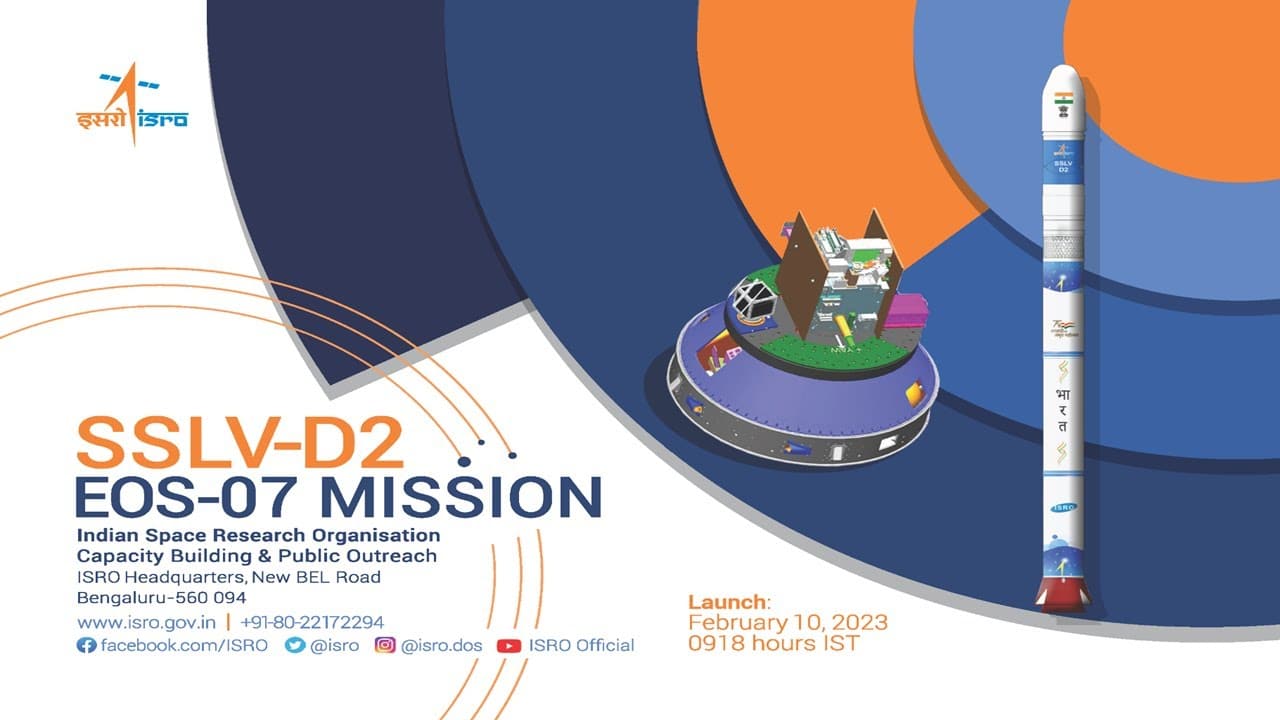What’s in today’s article?
- Why in News?
- What is a Small Satellite Launch Vehicle (SSLV)?
- What are the key features of SSLV?
- What’s Onboard the SSLV-D2?
Why in News?
- In its second development flight, the Indian Space Research Organisation’s (ISRO) smallest vehicle – Small Satellite Launch Vehicle (SSLV-D2), was launched from the Satish Dhawan Space Centre SHAR, Sriharikota, Andhra Pradesh.
- It will place the ISRO’s earth observation satellite EOS-07 and two co-passenger satellites – Janus-1 and AzaadiSat2 – developed by start-ups, in a 450-km circular orbit around the Earth.
What is a Small Satellite Launch Vehicle (SSLV)?
Image Caption: SSLV vs PSLV
- SSLV is a 3 stage Launch Vehicle configured with –
- Three Solid Propulsion Stages and
- Liquid propulsion-based Velocity Trimming Module (VTM) as a terminal stage.
- It is 2m in diameter and 34m in length with a lift off weight of ~120 tonnes and is capable of launching ~500 kg satellite in 500 km planar orbit from SHAR.
What are the key features of SSLV?
The key features of SSLV are –
- Low cost,
- With low turn-around time,
- Flexibility in accommodating multiple satellites,
- Minimal launch infrastructure requirements (assembled by a small team in a week, compared to 6 months and 600 people for ISRO’s workhorse PSLV), etc.
- The new vehicle was developed to capture the emerging small (nano-micro-mini) satellite commercial market, with launches offered on demand.
- The vehicle’s first development flight (August 2022, EOS 02), failed to place the satellites in precise orbit.
- A new vehicle is declared operational by the space agency after it completes two successful development flights.
- The last vehicle to be declared operational was the GSLV Mk III, now called LVM 3, when it carried Chandrayaan-2 in 2019.
What’s Onboard the SSLV-D2?
- Janus-1 (weight 10.2 kg) is a technology demonstrator satellite built by US-based Antaris and its Indian partners XDLinks and Ananth Technologies.
- It is a cube satellite with five payloads on board – two from Singapore, and one each from Kenya, Australia, and Indonesia.
- AzaadiSat2 is a Cubesat weighing around 8 kg and carries 75 different payloads.
- Girl students from rural regions across the country were provided guidance to build these payloads.
- The payloads are integrated by the student team of “Space Kidz India”.
- EOS-07 is a 156.3 kg satellite designed, developed and realized by ISRO.
- Its mission objective is to design and develop payload instruments compatible with microsatellite buses and new technologies for future operational satellites.
- It would also design and develop a microsatellite accommodating new technology payloads in a quick turn-around time.
Q1) When does ISRO declare a new vehicle operational?
A new vehicle is declared operational by the space agency after it completes two successful development flights. The last vehicle to be declared operational was the GSLV Mk III, now called LVM 3, when it carried Chandrayaan-2 in 2019.
Q2) What are the key features of ISRO’s SSLV vehicle?
Key features of SSLV are low cost, with low turn-around time, flexibility in accommodating multiple satellites, minimal launch infrastructure requirements (assembled by a small team in a week, compared to 6 months and 600 people for ISRO’s workhorse PSLV), etc.
Source: ISRO’s SSLV-D2: The mini vehicle’s second flight, with promise on board | TH | ISRO | India Today
Last updated on June, 2025
→ UPSC Notification 2025 was released on 22nd January 2025.
→ UPSC Prelims Result 2025 is out now for the CSE held on 25 May 2025.
→ UPSC Prelims Question Paper 2025 and Unofficial Prelims Answer Key 2025 are available now.
→ UPSC Calendar 2026 is released on 15th May, 2025.
→ The UPSC Vacancy 2025 were released 1129, out of which 979 were for UPSC CSE and remaining 150 are for UPSC IFoS.
→ UPSC Mains 2025 will be conducted on 22nd August 2025.
→ UPSC Prelims 2026 will be conducted on 24th May, 2026 & UPSC Mains 2026 will be conducted on 21st August 2026.
→ The UPSC Selection Process is of 3 stages-Prelims, Mains and Interview.
→ UPSC Result 2024 is released with latest UPSC Marksheet 2024. Check Now!
→ UPSC Toppers List 2024 is released now. Shakti Dubey is UPSC AIR 1 2024 Topper.
→ Also check Best IAS Coaching in Delhi






















